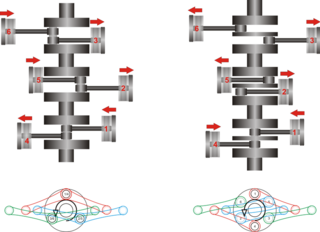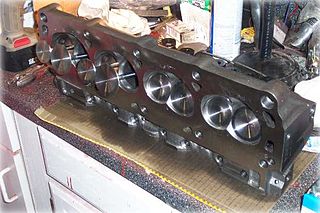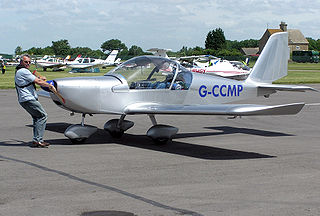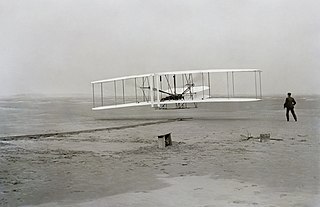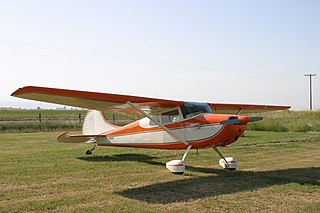
The Lycoming O-235 is a family of four-cylinder, air-cooled, horizontally opposed piston aircraft engines that produce 100 to 135 hp, derived from the earlier O-233 engine.

The Lycoming O-540 is a family of air-cooled six-cylinder, horizontally opposed fixed-wing aircraft and helicopter engines of 541.5 cubic inch displacement, made by Lycoming Engines. The engine is a six-cylinder version of the four-cylinder Lycoming O-360.

The Continental R-670 was a seven-cylinder four-cycle radial aircraft engine produced by Continental displacing 668 cubic inches and a dry weight of 465 lb (211 kg). Horsepower varied from 210 to 240 at 2,200 rpm. The engine was the successor to Continental's first radial engine, the 170 hp Continental A-70. This engine was used on many aircraft in the 1930s and 1940s. The R-670 was widely used in the PT-17 Stearman primary training aircraft of the U.S. military.
The Lycoming O-290 is a dual ignition, four-cylinder, air-cooled, horizontally opposed aircraft engine. It was first run in 1939, and entered production three years later.
The Lycoming IO-720 engine is a large displacement, horizontally opposed, eight-cylinder aircraft engine featuring four cylinders per side, manufactured by Lycoming Engines.
The Continental IO-346 engine is a fuel-injected four-cylinder aircraft engine that was developed especially for the Beechcraft Musketeer Custom III by Continental Motors. It was produced for that aircraft between 1965 and 1969.

The Continental O-240 engine is a four-cylinder, horizontally opposed, air-cooled aircraft engine that was developed in the late 1960s for use in light aircraft by Continental Motors, Inc. The first O-240 was certified on 7 July 1971.

The Lycoming O-145 is a family of small, low-horsepower, four-cylinder, air-cooled engines. It was Lycoming Engines' first horizontally opposed aircraft engine and was produced from 1938 until the late 1940s. The family includes the reduction-geared GO-145. The O-145 received its Approved Type Certificate on 13 Jun 1938.

The Continental O-470 engine is a family of carbureted and fuel-injected six-cylinder, horizontally opposed, air-cooled aircraft engines that was developed especially for use in light aircraft by Continental Motors. Engines designated "IO" are fuel-injected.

The Continental IO-550 engine is a large family of fuel injected six-cylinder, horizontally opposed, air-cooled aircraft engines that were developed for use in light aircraft by Teledyne Continental Motors. The first IO-550 was delivered in 1983 and the type remains in production.
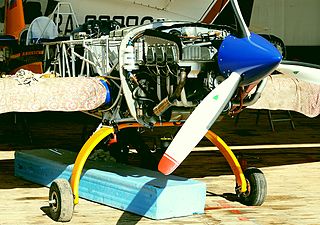
The Lycoming IO-580 engine is a horizontally opposed, six-cylinder aircraft engine featuring three cylinders per side, manufactured by Lycoming Engines.
The Lycoming GSO-580 is a family of eight-cylinder horizontally opposed, supercharged, carburetor-equipped aircraft engines for both airplanes and helicopters, manufactured by Lycoming Engines in the late 1950s and early 1960s.

The Lycoming IO-390 engine is a horizontally opposed, four-cylinder aircraft engine, manufactured by Lycoming Engines.
The Lycoming TIO-541 engine is a turbocharged, fuel-injected, horizontally opposed, six-cylinder aircraft engine featuring three cylinders per side, manufactured by Lycoming Engines.
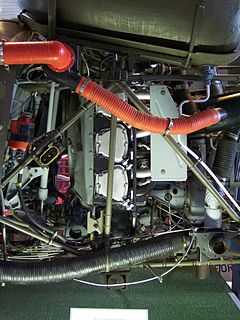
The Lycoming O-435 is a six-cylinder, horizontally opposed fixed-wing aircraft and helicopter engine made by Lycoming Engines. The engine is a six-cylinder version of the four-cylinder Lycoming O-290.

The Lycoming IO-233 is a non-certified four-cylinder, air-cooled, horizontally opposed piston aircraft engine that produces between 100 hp (75 kW) and 116 hp (87 kW).
The Nelson H-63, known in the US military designation system as the YO-65, is an American dual ignition, four-cylinder, horizontally opposed, two-stroke aircraft engine that was developed by the Nelson Engine Company for use in helicopters and light aircraft. The engine designation means horizontally opposed 63 cubic inch displacement.
The ECi O-320 is part of a family of normally aspirated, air-cooled, four-cylinder, direct-drive engines developed for certified and experimental aircraft. Its cylinders are arranged in horizontally opposed configuration and a displacement of 320 cubic inches (5.24 L). It is based on the Lycoming O-320 engine with ECi cylinder assemblies.
